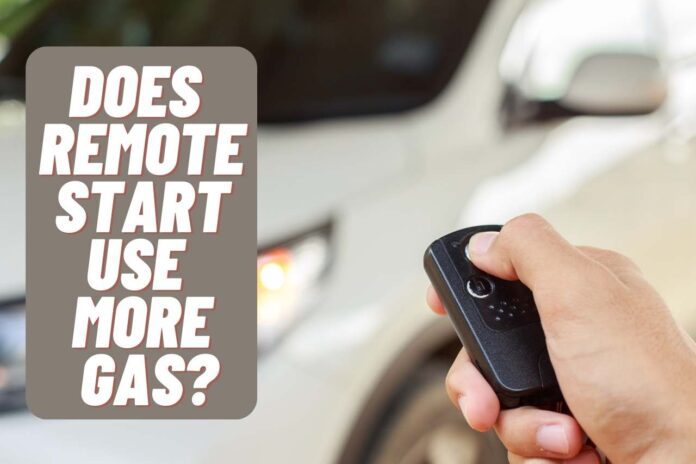You may start your automobile remotely, without a key or even while inside the vehicle, by utilizing the new technologies that tablets and smartphones offer. The ability to remotely lock and unlock a car using a key fob is now a standard feature on several new cars, and we predict that remote start will follow suit in the near future. Some people, however, are dubious about the actual impact of this remote start option on their gas economy and prices. So they might be wondering that, does remote start use more gas? Keep on reading to know all about queries.
Is There a Need for a Remote Start?
Like heated seats, a remote start is undoubtedly a convenience feature, but after you get one installed, you’ll wonder how you ever managed without it. You’ll discover the wonderful advantages of using the button to remotely start the car and wipe the snow off your windshield. Remote starts might also help your engine’s motor last longer in the cold.
Does Remote Start Use More Gas?
So, does remote start use more gas? A car’s remote start or auto start technology doesn’t truly consume more gasoline and won’t lead to an increase in fuel usage. The exact quantity of gas gets burned while starting a car remotely and using the key to initiate the ignition sequence.
A remote start’s primary function is to run the engine idle for five to ten minutes in very hot or cold conditions so that you can enter your car and enjoy the specified temperature inside. Most engines run for up to ten minutes after a remote start before turning off automatically to prevent further fuel use. Although you can increase the engine’s run time with a remote start, the longer the engine is idle, the less fuel efficient it will be.
Myths About Gas Consumption
Idling and temperature control are the two most often mentioned causes of higher fuel use while starting a car remotely. MPG decreases while the engine is idle since fuel gets used when the vehicle is stationary. Depending on the size of the vehicle, idling fuel consumption ranges between 0.2 to 0.5 gal/h for passenger cars. As a result, the engine can use up to 0.08 gallons of petrol or gas throughout a remote start that lasts up to 10 minutes.
Climate control and remote start function similarly. An idling automobile is moving very slowly while the engine is still operating. It somewhat lowers a car’s fuel efficiency (MPG). However, letting the engine warm up before moving is good for the engine as well as its components. Therefore, idling heating or cooling systems for an extended period impacts fuel usage.
Before getting into your car, idling the engine or remotely starting it enables all parts to receive complete lubrication as the motor oil warms up and flows readily to all sections of the engine. You will prefer a remote start option to warm up your car and control the temperature within its cabin during extremely cold weather conditions rather than getting into a chilly car and waiting for the engine to warm up.
Getting warmed up your engine in cold weather makes it easier for lubricating fluids to flow through the oil galleries and to various engine parts, reducing the likelihood of clogging the engine. In the long term, a cleaner engine with well-functioning mechanical parts will contribute to higher fuel economy.
The remote start option makes use of the climate control system to either heat the inside and defrosts the windshields and window frames in cold weather or to cool the interior to a set degree and cool down the leather or vinyl seats so you won’t get burned in hot weather. It is another reason why people believe remote start increases fuel consumption.
If you employ a remote-start option, the engine run duration gets often set by factory default to 10 minutes. However, automobile owners frequently increase the engine run duration on remote starts to create a comfortable, warm climate inside their vehicles. You know how much gasoline or gas the engine heating system uses. Just consider how much the fuel economy might impact if your car is idling for more than 10 minutes when the heating, defrosting, or air conditioning is on.
More Myths About Remote Start
Increase Engine Wear and Tear
This is a typical misunderstanding about remote starters. It’s inaccurate, and why individuals believe this is unknown. The general opinion among mechanics would be that remote starts benefit your engine, particularly those with turbocharged or diesel motors.
The oil in your automobile thickens in cold weather. The viscosity of the oils is increased during engine warming to ensure adequate circulation. Thus, preheating the engine makes your drivetrain last longer. Since they warm up the engine before usage, remote starters benefit your vehicle’s engine.
Does the Remote Start Use Gas or Battery?
An electrical method called remote starting makes use of the car’s battery. A control module for remote starting can read and process signals delivered by the key fob.
A remote start receiver takes the transmitter’s signal, turns on the systems it is attached to, and simulates the engine’s start-up process. It enables the engine to start, switches on features like heating or cooling, and verifies that the doors are secured.
Even when the engine is off and waiting for an instruction from your key fob, the remote start system uses a tiny amount of battery power.
Final Thought
A remote car start device is a great indulgence that makes leaving much more convenient. Now you know, does remote start use more gas. So, never again must you enter a chilly vehicle! Just be sure you do your homework to choose the best system for your car and that you deal with an experienced installer to get the system installed.
You May Also Like




